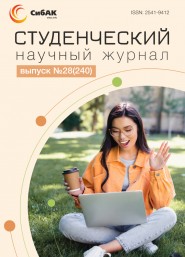Статья опубликована в рамках: Научного журнала «Студенческий» № 28(240)
Рубрика журнала: Филология
Секция: Литературоведение
Скачать книгу(-и): скачать журнал часть 1, скачать журнал часть 2, скачать журнал часть 3, скачать журнал часть 4
ANALYZING STOKER'S NARRATIVE CHOICE: UNVEILING DRACULA THROUGH JOURNALS, LETTERS, AND NEWSPAPER CLIPPINGS
АНАЛИЗ ПОВЕСТВОВАТЕЛЬНОГО ВЫБОРА СТОКЕРА: РОМАН "ДРАКУЛА" ЧЕРЕЗ ДНЕВНИКИ, ПИСЬМА И ГАЗЕТНЫЕ ВЫРЕЗКИ
Овсепян Юрий Арменакович
студент, факультет иностранных языков и регионоведения, Московский Государственный Университет имени М.В. Ломоносова,
РФ, г. Москва
АННОТАЦИЯ
Культовый роман Брэма Стокера «Дракула», опубликованный в 1897 г., уже более ста лет покоряет читателей своей леденящей душу историей о печально известном вампире. Одним из наиболее интригующих аспектов романа является то, что Стокер решил изложить историю в основном через дневники, письма и газетные вырезки. Такой уникальный подход придает роману глубину, «саспенс» и ощущение непосредственности. В этой статье мы рассмотрим достоинства и недостатки решения Стокера использовать эпистолярный формат.
ABSTRACT
Bram Stoker's iconic novel "Dracula," published in 1897, has captivated readers for over a century with its chilling tale of the infamous vampire. One of the most intriguing aspects of the novel is Stoker's narrative decision to recount the story primarily through journal entries, letters, and newspaper clippings. This unique approach adds depth, suspense, and a sense of immediacy to the story. In this article, we will explore the strengths and drawbacks of Stoker's decision to use this epistolary format.
Ключевые слова: “Дракула”, повествовательный формат, эпистолярное повествование, дневниковые записи Стокера.
Keywords: Dracula, Narrative Format, Epistolary Storytelling, Stoker's Journal Entries.
Strengths of the Epistolary Format:
Multifaceted Perspectives: Stoker's decision to present the narrative through various characters' perspectives enriches the storytelling. By using journal entries and letters, readers gain insight into the characters' inner thoughts, emotions, and fears. This approach enables Stoker to explore the psychology of his characters in a more intimate and profound manner, creating a complex web of interconnected experiences.
Realism and Immersion: The epistolary format lends an air of authenticity and realism to the narrative. The letters and journals mimic genuine documents, making the story feel like a compilation of firsthand accounts. This engrossing effect pulls readers into the world of the novel, heightening the tension and fear as if the events are unfolding in real time.
Suspense and Mystery: The fragmented nature of the epistolary format generates suspense and mystery. As readers piece together information from various sources, they are compelled to uncover the truth behind the unfolding events. The gradual revelation of information creates a sense of intrigue and heightens the overall sense of foreboding.
Unreliable Narrators: Through the use of multiple narrators, Stoker introduces the possibility of unreliable storytelling. Each character has their own biases, perspectives, and limited knowledge. This allows Stoker to manipulate readers' perceptions and engage them in critical thinking as they sift through the contrasting viewpoints to form a complete picture of the story.
Reflecting Societal Concerns: Stoker's choice of format also allows him to address prevalent societal concerns of the Victorian era. The characters' reactions to the supernatural and their efforts to rationalize the inexplicable mirror the societal struggle to reconcile scientific advancements with traditional beliefs.
Drawbacks of the Epistolary Format:
Limited Perspective: While the multifaceted perspectives are a strength, they can also be a drawback. The epistolary format restricts readers to the viewpoints of the characters who are writing the journals and letters. This can lead to gaps in the narrative, leaving certain events unexplored or ambiguously explained.
Pacing Challenges: The use of various sources can sometimes result in uneven pacing. Readers might find some sections of the story slow or less engaging, as the narrative momentum can be disrupted by the shift in perspectives and writing styles.
Lack of Direct Dialogue: The epistolary format often limits the inclusion of direct dialogue. While character interactions can be inferred from the letters and journals, readers miss out on the immediacy and depth that direct conversations can provide.
Conclusion
Bram Stoker's decision to recount the story of "Dracula" through journal entries, letters, and newspaper clippings is a masterstroke that infuses the novel with an array of strengths and challenges. The multifaceted perspectives, immersion, suspense, and psychological depth created by this format have contributed to the novel's enduring appeal. However, the limitations in perspective, pacing, dialogue, and realism warrant consideration. Ultimately, the epistolary format remains an ingenious narrative device that has left an indelible mark on the horror genre and continues to be admired and emulated by writers and readers alike.
Reference:
- Brooks, Peter. "Reading for the Plot: Design and Intention in Narrative." Harvard University Press, 1992.
- Stoker, Bram. "Dracula." Archibald Constable and Company, 1897.


Оставить комментарий